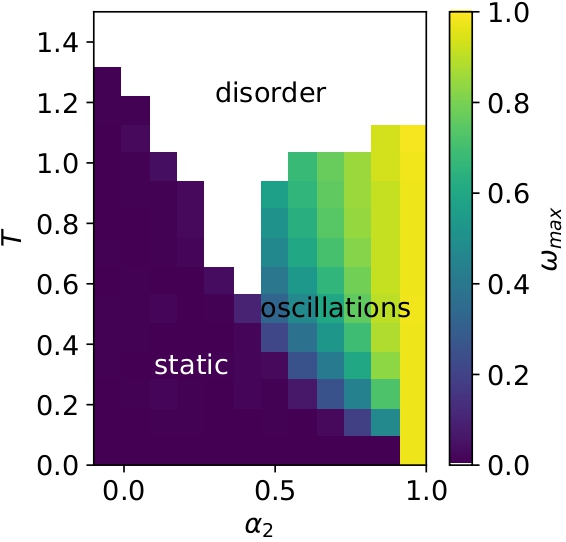Publications
You can also have a look at my scholar profile
2025
-
 Nonreciprocal Spin-Glass Transition and AgingGiulia Garcia Lorenzana , Ada Altieri , Giulio Biroli , Michel Fruchart , and Vincenzo VitelliPhysical Review Letters, 2025
Nonreciprocal Spin-Glass Transition and AgingGiulia Garcia Lorenzana , Ada Altieri , Giulio Biroli , Michel Fruchart , and Vincenzo VitelliPhysical Review Letters, 2025Disordered systems generically exhibit aging and a glass transition. Previous studies have long suggested that non-reciprocity tends to destroy glassiness. Here, we show that this is not always the case using a bipartite spherical Sherrington-Kirpatrick model that describes the antagonistic coupling between two identical complex agents modeled as macroscopic spin glasses. Our dynamical mean field theory calculations reveal an exceptional-point mediated transition from a static disorder phase to an oscillating amorphous phase as well as non-reciprocal aging with slow dynamics and oscillations.
-
 Nonreciprocally coupled spin glasses: Exceptional-point-mediated phase transitions and agingGiulia Garcia Lorenzana , Ada Altieri , Giulio Biroli , Michel Fruchart , and Vincenzo VitelliPhysical Review E, 2025
Nonreciprocally coupled spin glasses: Exceptional-point-mediated phase transitions and agingGiulia Garcia Lorenzana , Ada Altieri , Giulio Biroli , Michel Fruchart , and Vincenzo VitelliPhysical Review E, 2025
2024
-
 Corrections to the Bethe lattice solution of Anderson localizationMatilde Baroni , Giulia Garcia Lorenzana , Tommaso Rizzo , and Marco TarziaPhysical Review B, May 2024
Corrections to the Bethe lattice solution of Anderson localizationMatilde Baroni , Giulia Garcia Lorenzana , Tommaso Rizzo , and Marco TarziaPhysical Review B, May 2024We study numerically Anderson localization on lattices that are tree-like except for the presence of one loop of varying length 𝐿. The resulting expressions allow us to compute corrections to the Bethe lattice solution on (i) random-regular-graph (RRG) of finite-size 𝑁 and (ii) Euclidean lattices in finite dimension. In the first case we show that the prefactor of the 1/𝑁 corrections to the average values of the typical density of states diverges exponentially approaching the critical point. In the second case our results, combined with the 𝑀-layer expansion, predict that corrections destroy the exotic critical behavior of the Bethe lattice solution in any finite dimension, strengthening the suggestion that the upper critical dimension of Anderson localization is infinity. Our approach explains the puzzling observation that the numerical simulations on finite RRGs deviate spectacularly from the expected asymptotic behavior, and opens the way to the computation of non-mean-field critical exponents by resumming the series of diverging diagrams through the same recipes of the field-theoretical perturbative expansion.
-
 Interactions and Migration Rescuing Ecological DiversityGiulia Garcia Lorenzana , Ada Altieri , and Giulio BiroliPRX Life, Mar 2024
Interactions and Migration Rescuing Ecological DiversityGiulia Garcia Lorenzana , Ada Altieri , and Giulio BiroliPRX Life, Mar 2024How diversity is maintained in natural ecosystems is a long-standing question in Theoretical Ecology. By studying a system that combines ecological dynamics, heterogeneous interactions, and spatial structure, we uncover a new mechanism for the survival of diversity-rich ecosystems in the presence of demographic fluctuations. For a single species, one finds a continuous phase transition between an extinction and a survival state, that falls into the universality class of Directed Percolation. Here we show that the case of many species with heterogeneous interactions is different and richer. By merging theory and simulations, we demonstrate that with sufficiently strong demographic noise, the system exhibits behavior akin to the single-species case, undergoing a continuous transition. Conversely, at low demographic noise, we observe unique features indicative of the ecosystem’s complexity. The combined effects of the heterogeneity in the interaction network and migration enable the community to thrive, even in situations where demographic noise would lead to the extinction of isolated species. The emergence of mutualism induces the development of global bistability, accompanied by sudden tipping points. We present a way to predict the catastrophic shift from high diversity to extinction by probing responses to perturbations as an early warning signal.
2022
-
 Well-Mixed Lotka-Volterra Model with Random Strongly Competitive InteractionsG. Garcia Lorenzana , and A. AltieriPhysical Review E, Feb 2022
Well-Mixed Lotka-Volterra Model with Random Strongly Competitive InteractionsG. Garcia Lorenzana , and A. AltieriPhysical Review E, Feb 2022The random Lotka-Volterra model is widely used to describe the dynamical and thermodynamic features of ecological communities. In this work, we consider random symmetric interactions between species and analyze the strongly competitive interaction case. We investigate different scalings for the distribution of the interactions with the number of species and try to bridge the gap with previous works. Our results show two different behaviors for the mean abundance at zero and finite temperature, respectively, with a continuous crossover between the two. We confirm and extend previous results obtained for weak interactions: at zero temperature, even in the strong competitive interaction limit, the system is in a multiple-equilibria phase, whereas at finite temperature only a unique stable equilibrium can exist. Finally, we establish the qualitative phase diagrams and compare the species abundance distributions in the two cases.